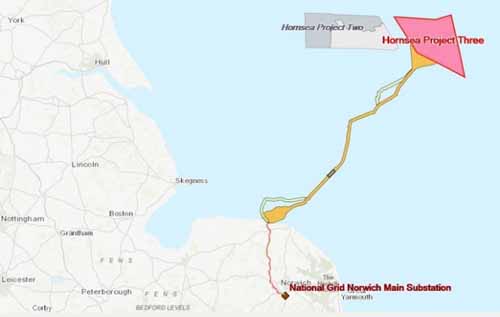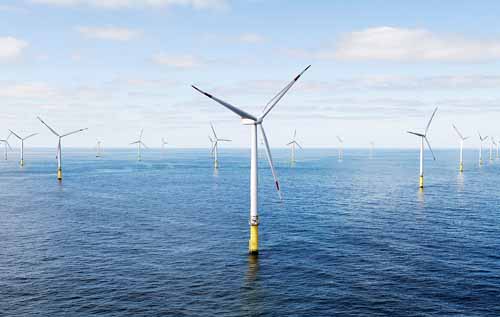A Development Consent Order (DCO) application for Hornsea Project Three, a new offshore wind farm that Danish energy group Ørsted is proposing to develop in the North Sea, has been accepted by the Planning Inspectorate (PINS) for examination.

If approved, the onshore cables for the new windfarm will pass through the Reepham district from Weybourne on the north Norfolk coast to a new substation at Swardeston, south of Norwich.
In response to earlier consultations, Ørsted has reduced the maximum number of phases that Hornsea Three could be built-out in from three to two phases. This has reduced the overall window of onshore construction from a maximum of 11 years to eight years.
The company has also committed to using horizontal direction drilling (HDD) under main rivers and all public roads, which will avoid the need for any road closures.
Ørsted has yet to announce whether it will use high-voltage direct current (HVDC) technology or the more common high-voltage alternating current (HVAC) technology to transmit power from its offshore wind farm to the National Grid substation.
However, Vattenfall has decided to use the newer HVDC technology for its proposed Norfolk Vanguard and Norfolk Boreas offshore wind farms.
The Swedish state-owned company said the deployment of HVDC will require a narrower onshore cable corridor and avoid the need to build cable relay stations, with its power transmission cables extending from Happisburgh on the coast through to the National Grid substation at Necton near Swaffham.
The Vattenfall onshore cables will also pass through the Reepham district and are planned to cross the Ørsted cables just north of Reepham in Salle parish.
Vattenfall is expected to submit its final plans for the 1.8 GW Norfolk Vanguard to the Planning Inspectorate shortly. Norfolk Boreas, also 1.8 GW, is following Norfolk Vanguard in the planning process.
Speaking at the Annual Reepham Town Meeting in May, Sue Falch-Lovesey, Vattenfall UK’s local liaison officer and skills champion, said the company will not be closing Marriott’s Way at any stage during the cable-laying process, but will use HDD under the footpath, bridleway and cycle path.
She added that Marriott’s Way will not be used as a “running track” for access to the cable trenches.
Vattenfall has said that HDD will also be used to cross main watercourses, main roads, railways and county wildlife sites – but not minor roads. In general, it is planned that road crossings will be executed within one week to minimise disruption.
During cable installation, crossings of two-lane roads will be managed without full closure of the road, but with temporary traffic lights; however, crossings of single-lane roads will require temporary road closure.
“We will aim to keep major traffic off all public roads where possible during the main trenching period and installation of cable ducting,” said Ms Falch-Lovesey.
She added that Vattenfall will be developing a traffic management plan that will avoid equipment deliveries between 8–9 am and not trenching across roads during school term time.
While praising Vattenfall for its decision to use HVDC technology, local resident Ray Pearce criticised both Vattenfall and Ørsted for their non-disclosure agreement regarding how the companies will co-ordinate their plans, particularly the management of the crossover point of the cables near Reepham.
“Our MP [Keith Simpson] should be involved on our behalf to ask questions of the Secretary of State [for Business, Energy and Industrial Strategy],” he told the meeting.
How to view and comment on Ørsted’s DCO application
A copy of Ørsted’s environmental impact assessment non-technical summary, as well as a USB stick containing the full application, is available to view at Reepham Library in the Bircham Centre, Market Place, Reepham (opening times: Monday 2–7 pm, Wednesday 9.30 am – 1 pm and 2–5 pm, Friday 10 am – 1 pm and 2–5 pm, Saturday 9.30 am – 12.30 pm).
Any representations (giving notice of any interest in, or objection to, the application) must be made on the Planning Inspectorate’s (PINS’) registration and relevant representation form.
Representations must be received by the Planning Inspectorate before midnight on 22 July.
Following the representation period, PINS will appoint an examining authority and interested parties will be invited to attend a preliminary meeting at a date to be determined by PINS.
Typically, the pre-examination period lasts around three months after which the formal examination begins, which can take up to six months.
After the examination stage, PINS has three months to prepare a report, including a recommendation for the Secretary of State for Business, Energy and Industrial Strategy, who then has a further three months to grant or refuse development consent.
If granted consent (a decision is anticipated in late 2019), Ørsted will seek to apply for a government subsidy and if successful, construction could commence as early as late 2020.
See our earlier stories:
- Farm manager’s fears over wind farm cable corridors
- Vattenfall to answer questions at Annual Town Meeting
- Pettywell residents up in arms about revised windfarm cable route
- Wind farm operators announce changes to onshore cable proposals

